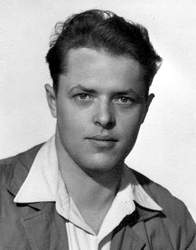Memorial exhibition of László Drégely I.
1953-1963
July 22, 2017
László DRÉGELY (Pécs, 1932 - Budapest 1990)
 26 years old
26 years old
VirtuartNet introduces a series of virtual exhibition illustrating Drégely’s lifework. The first collection will highlights the between 1953-1963.
He was born in Pécs. He attended both primary and secondary school there. Already in the secondary school he started to paint and design scenery. He studied scenery-design at the Hungarian University of Applied Arts from 1951 to 1953. After leaving the University Endre Bálint and Jenő Gadányi were his mentors.
From 1958 to 1978 he worked as a set-designer at the Hungarian Television but during this period his numerous scenery designs were used in both theatres and movies as well.
As a painter he first occurred at the National Salon and his first solo-exhibition took place in 1962, in Budapest.
From 1968 on he had several solo-exhibitions abroad – in France, The Netherlands, the FRG (Federal Republic of Germany), Denmark, Poland and in Canada – at different places and at multiple times did he answer the invitations. From the 1980-ies on he occurred on fewer exhibitions because of his illness.
His lifework was awarded by Balázs Béla Prize in 1972 and with Érdemes Művész (Meritorious Artist) Award in 1977 and in 1980 he was given the Budapest Medallion. He was elected to be a life member of the Hungarian Television.
Éva Körner – a well acquainted knower of László Drégely’s art – wrote the following in her book, Drégely (Budapest, 1972):
László Drégely is one of the most powerful members of the young Hungarian artist generation. A never resting urge drives him to interpret his personal inner world, the outward world, his personal fate and the events of his surroundings. His symbol-system is so powerful and is coming from such a depth that they stay unaltered in every pace of his artistic travel. In all of the „white” the „red”, the drawn or in the soluted painting sets, the following ancient symbols turn up: the eye, the wing, the clock, the candle, and the man-woman dual unity… There are a few newer symbols still complementing the previous circle: the knife, the shooting-gallery, the human-machine. Drégely’s painting is greatly matter-full.
He basically relies on the power of the objects’ symbolism, but still his specially artistic tweaks: the management of colours and space – spaces left empty without any object or on the contrary spaces crowded with objects – bear an important significance.”
About the clocks found in his works he said the following:
“In the middle ages every painter painted a cross on his painting. That was the symbol of the era. I paint clocks because I feel that to be the best symbol of our running time. What does the clock mean? Maybe a bit of the winged time, the unmerciful time. Somehow it reminds me of our passing.”
He was an experimenting artist, who was always testing himself and who managed to create everlasting things in all the branches of his fine arts. Besides the conventional panel painting he possessed a unique oeuvre: he carved, painted stones, marble, bended, etched, embossed metal, aluminium and under his hands the simple top of a chest or a shabby piece of wood turned into a beautiful picture or icon.
Ágnes GÁBOR















































